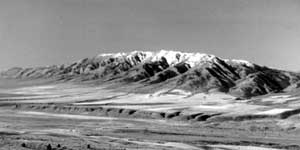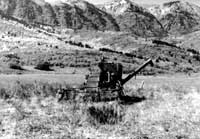|
Page
1
|
Introductory
Remarks
Eastern Idaho is
a backwater; even as we approach the 21st century it is by-and-large undiscovered,
underdeveloped, sparsely populated. This book is an attempt to celebrate this
beautiful and fascinating corner of America, to describe, in words and pictures,
its history and geology.
 |
| Old Tom Mountain from Rock Creek in the Portneuf Range, looking southwest, (October, 1985). Marsh Valley in foreground. The stark mountains await the winter snows. |
This book grows out of a class of the same name that we have taught since 1986 at Idaho State University. The central notion behind the class and thus the book, is that the geology and history of eastern Idaho are closely linked. In addition, we found that there is no one source that combines these two topics, and that by using historical and modern photographs we could produce a book that is both attractive and useful.
A Disclaimer
We must
now state what this book is not. We are not trained historians and have not
tried to write a definitive history book. Rather, this is a collection of anecdotes
and facts that seem to us important. We have provided references to scholarly
history sources, which we recommend to the reader. We make no apologies for
the geology, however.
Organization
The book is organized
into two primary parts. The first covers the geology and history of eastern
Idaho from a topical and chronological point of view. The geology review should
be especially useful for those wishing ready access to the Idaho geological
literature. The second part contains regional snapshots of each part of eastern
Idaho, complete with maps and references. Each of these snapshots is self-contained
and covers trail routes, geology and interesting historical elements of eastern
Idaho.
We spent a great deal of time and had some fun assembling and taking the pictures in this book. The captions, especially of the historical photos, are important and contain details not found in the text.
We wanted to publish the book through ISU in an attempt to keep the project in Pocatello. ISU Press published the first edition. We are delighted that the second edition is published by the Idaho Museum of Natural History.
 |
| Abandoned combine west of Oxford, (October, 1978). Oxford Peak, underlain by Late Proterozoic quartzite of the Brigham Group, is in the background. |
Geography
and Culture
The southeastern
corner of Idaho, largely Mormon (The Church of Jesus Christ of Latter Day Saints),
has always had conflicting loyalties. After cruel political and religious persecution
in the late 19th century, Idaho Mormons have good reason to feel estranged from
the rest of their geographically awkward state. Their cultural and religious
ties are with Utah to the south.
Pocatello
Pocatello
has been the transition zone, the interface, between the "true" Idaho
of the Snake River Plain, and the southeastern corner. Located at the mouth
of Portneuf Narrows, the water level route to the Snake River Plain, Pocatello
is the Gate City to the Pacific Northwest. It is a railroad town and a melting
pot, a windy place where people came and went under the instructions of Oregon
Short Line managers from Omaha. After years of economic stability, Pocatello
in 1996 is one of the fastest growing cities in the Pacific Northwest.
Nestled along the Portneuf River in what had been a sage-covered treeless valley, Pocatello has treated its natural environment cruelly. It grew with sprawling industrial sites and phosphate plants built where subject to reduced tax liabilities, but sited in the worst location for air pollution of the city downwind to the east.
Pocatello welcomed the U.S. Army Corps of Engineers who built in 1965 a concrete flood control channel which imprisons the Portneuf River. The channel is a manifestation of pragmatism that lacks environmental sensitivity.
But Pocatello is a city without an upper class. In a fundamentally blue-collar town with no landed aristocracy who stayed for generations, practicality repeatedly won out over aesthetics. So it goes.